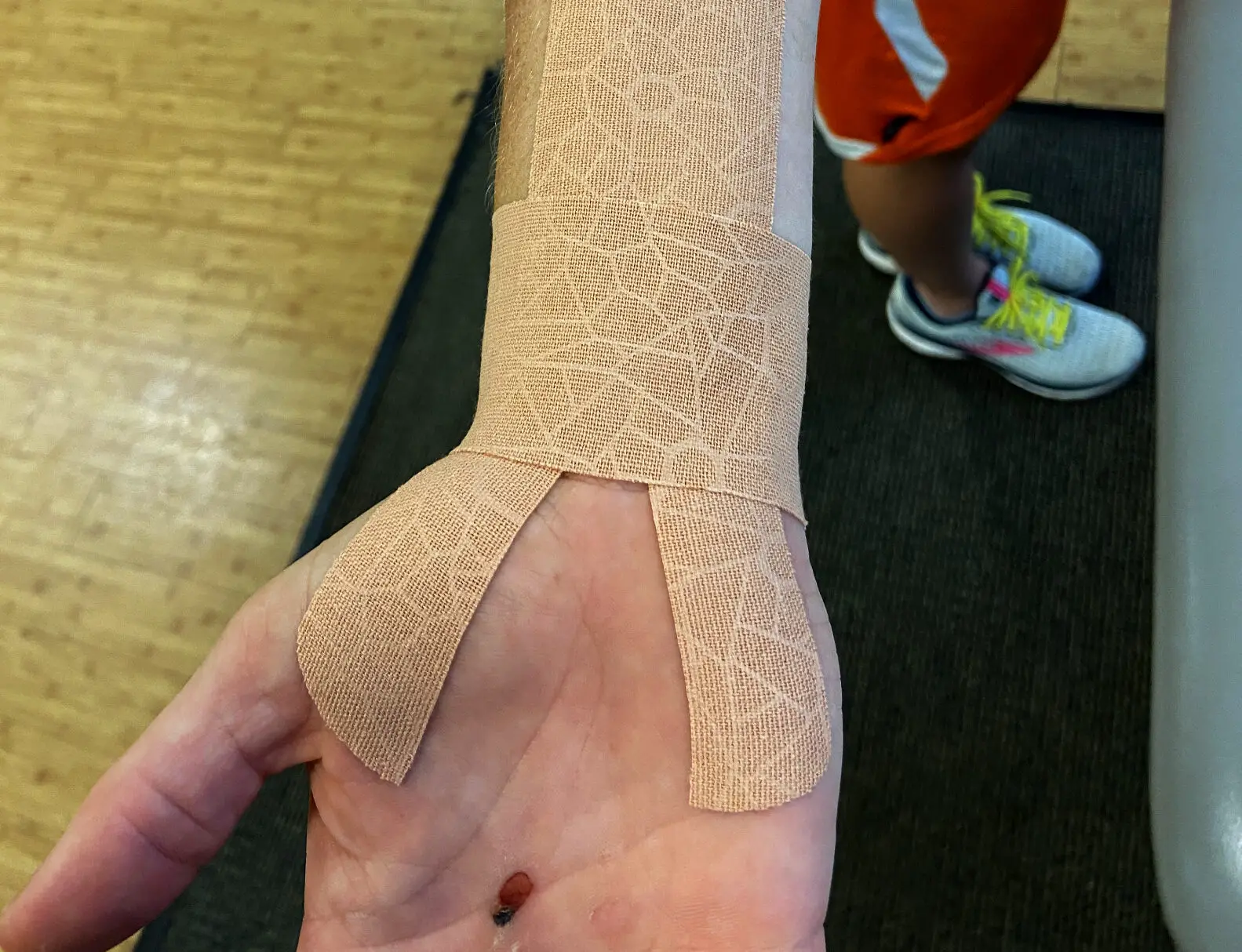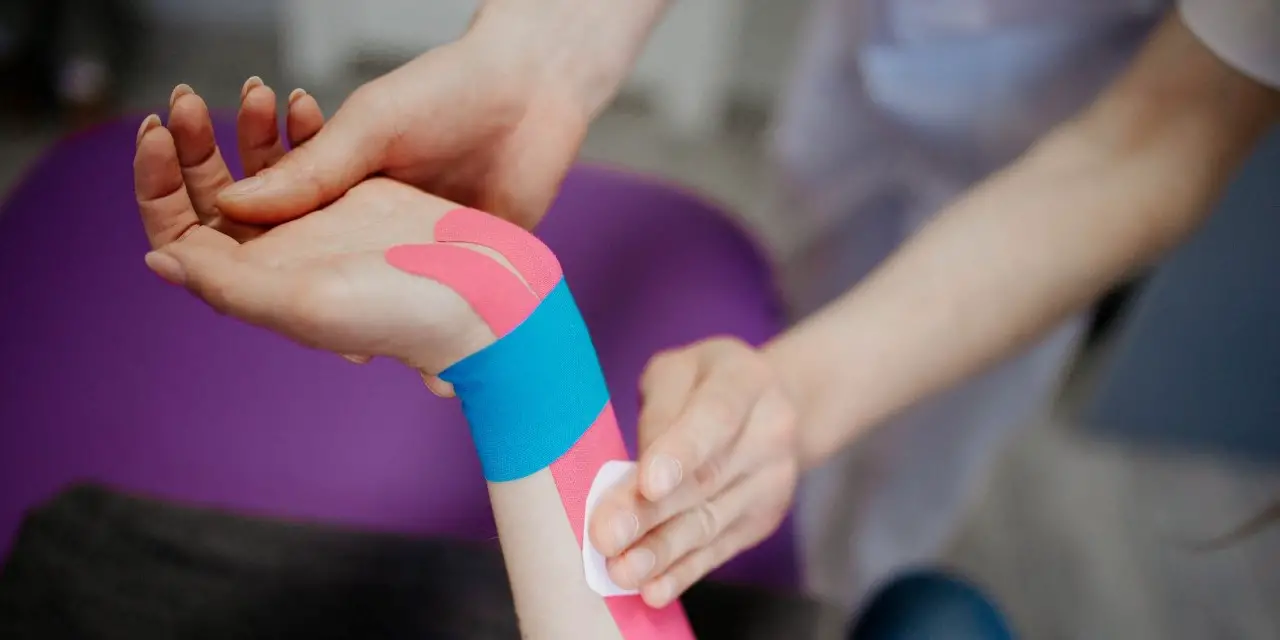Kinesiology tape, or KT tape, is often used as a conservative treatment for pain relief and to support the joints to reduce the risk of injury and improve athletic performance. It’s similar to regular athletic tapes that you often see in drugstores, but unlike them, KT tape is more elastic, waterproof, and comes in a variety of colors.
Many people use taping for carpal tunnel syndrome, which is a painful condition in your wrist where the median nerve is compressed in the narrow “tunnel” of the wrist. Any compression to the nerve can cause a tingling and numb sensation or severe pain that can make holding a mug or pen difficult.
While some evidence suggests that having surgery to alleviate nerve compression is more effective for pain relief and function than conservative treatments (e.g. splinting, medication, steroid injections, physical therapy), some researchers warned that most of the studies are low quality. These studies have different ways to set up the experiments, such as having different control groups, subjects, and bias from the researchers, which may lean in favor of surgeries.
Note: Don’t confuse KT Tape with Kinesio Tape. Even so, there’s not much difference in how you apply the tape and which tape you use.
How do you use KT Tape to the wrist?
There are several ways to taping your wrist if you have carpal tunnel syndrome or other types of wrist pain.
What you’ll need: scissors, KT Tape (or regular athletic tape).
- Wash your forearm, wrist, and hand with soap and water.
- Measure the distance from the tip of your thumb to the tip of your fifth finger with your hands and fingers opened wide. That’s about how long the tape should be.
- Cut about 2 inches in the middle of the tape so that it forms a Y shape.
- Peel off the paper from the two ends of the Y. With your forearm and wrist extended, place one end of the tape at each side of the palm (thumb, pinkie). There should be no tape tension.
- Peel off the rest of the paper from the tape. Make sure there are no wrinkles on the tape as your peel.
- Extend your wrist as you pull the tape toward the crook of your forearm with about 20-25% tension.
- Smooth the tape along the forearm to keep the tape firm.
- Take a second KT Tape and cut it to about the length of your palm.
- Place the tape partially around your wrist from the lateral side (thumb) to the medial side (pinkie) with your hands and forearm facing up. There should be no tension in the tape.
How do you remove KT Tape?
Peeling off the tape can be painful for some people, especially if you have low pain tolerance, hairy skin, or skin sensitivity. Following these guidelines may make removing KT Tape easier and less uncomfortable.
- Saturate the tape area with an oil-based lotion or cream.
- Gently peel the tape off away from your body to reduce the number of hair ripped from your arm (if you have hairy arms).
If you’ve had your tape on for about a week, it should also be easier to remove with no lotion or oil. If that’s still very uncomfortable or painful for you, use the lubricants.

Does KT Tape work for pain?
Overall, research finds that wrist taping has significant pain reduction with Kinesio Tape whether it’s used alone or with another intervention, as a 2021 literature review of 10 studies indicated. One issue the researchers found is that each study used a different set of comparisons, questionnaires and procedures, which can skew the review’s outcome.
A September 2022 systematic review and meta-analysis investigated the short-term effects of Kinesio Tape in patients with carpal tunnel syndrome. The study concluded that taping improved pain, function, and nerve conduction speed but it is critical to note that the effects on these variables were weak or very weak. These authors did note that it was difficult to compare outcomes across these studies because the taping technique wasn’t standardized.
Kinesio taping is not just used in the wrist. A systematic review and meta-analysis from Research in Sports Medicine found favorable results when it comes to reducing pain in all body regions. These authors reviewed 36 papers and found improvements in pain and disability when tape was applied to any body part; this remained true after four to six weeks of application. They concluded that tape should be used in conjunction with other therapies to provide patients with improved overall outcomes.
While KT Tape and Kinesio Tape proponents say that the tape “lifts” the skin to alleviate pressure on the tissues beneath the skin, the narrative doesn’t agree with basic human physiology.
The pain relief you get from taping is more likely from how your nervous system (peripheral nerves under your skin, spinal cord, and brain) perceives the taping and other non-specific effects from manual therapy, such as therapeutic relationships, your expectations, and distractions.
KT Tape precautions
While there’s little risk in worsening your carpal tunnel or other types of wrist pain with KT Tape and other tapes, check with your physician or physical therapist if your condition worsens over time, even if you have tried taping and other conservative methods.
Even if the effects of KT Tape or any kind of tape is mostly a placebo, physiotherapist and triathlete Paul Westwood warned that tape reliance could “promote the belief that their body is not good enough and they need an extrinsic factor (tape) to allow it to function.” He mentioned that the placebo effect might eventually wear off if the athlete relies too much on it.
Manual therapists who find taping useful should continue to use it, but they should be honest and transparent about how and why it might work for their patients.

Penny Goldberg, DPT, ATC
Penny Goldberg, DPT, ATC earned her doctorate in Physical Therapy from the University of Saint Augustine and completed a credentialed sports residency at the University of Florida. She is a Board Certified Clinical Specialist in Sports Physical Therapy.
Penny holds a B.S. in Kinesiology and a M.A. in Physical Education from San Diego State University. She has served as an Athletic Trainer at USD, CSUN, and Butler University.
She has presented on Kinesiophobia and differential diagnosis in complicated cases. Penny has published on returning to sports after ACL reconstruction and fear of movement and re-injury.
Outside of the clinic, Penny enjoys traveling, good cooking with great wine, concerts, working out and playing with her dogs.





